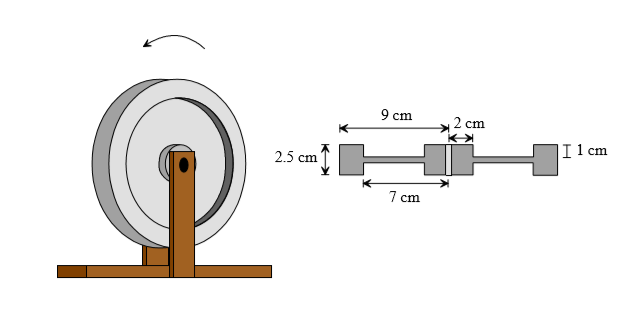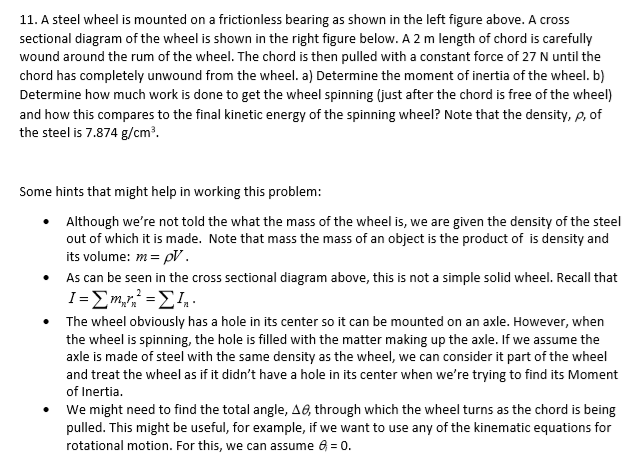9 cm 2 cm 2.5 cm |I l cm 7 cm 11. A steel wheel is mounted on a frictionless bearing as shown in the left figure above. A cross sectional diagram of the wheel is shown in the right figure below. A 2 m length of chord is carefully wound around the rum of the wheel. The chord is then pulled with a constant force of 27 N until the chord has completely unwound from the wheel. a) Determine the moment of inertia of the wheel. b) Determine how much work is done to get the wheel spinning (just after the chord is free of the wheel) and how this compares to the final kinetic energy of the spinning wheel? Note that the density, p, of the steel is 7.874 g/cm?. Some hints that might help in working this problem: • Although we're not told the what the mass of the wheel is, we are given the density of the steel out of which it is made. Note that mass the mass of an object is the product of is density and its volume: m= pV. • As can be seen in the cross sectional diagram above, this is not a simple solid wheel. Recall that Ι-Σm.y=ΣΙ. The wheel obviously has a hole in its center so it can be mounted on an axle. However, when the wheel is spinning, the hole is filled with the matter making up the axle. If we assume the axle is made of steel with the same density as the wheel, we can consider it part of the wheel and treat the wheel as if it didn't have a hole in its center when we're trying to find its Moment of Inertia. We might need to find the total angle, AG, through which the wheel turns as the chord is being pulled. This might be useful, for example, if we want to use any of the kinematic equations for rotational motion. For this, we can assume 6, = 0.
A steel wheel is mounted on a frictionless bearing as shown in the left figure above. A cross-sectional diagram of the wheel is shown in the right figure below. A 2 m length of the chord is carefully wound around the rum of the wheel. The chord is then pulled with a constant force of 27 N until the chord has completely unwound from the wheel.
a) Determine the moment of inertia of the wheel.
b) Determine how much work is done to get the wheel spinning (just after the chord is free of the wheel) and how this compares to the final kinetic energy of the spinning wheel?
Note that the density, p, of the steel is 7.874 g/cm3.
Some hints that might help in working this problem:
*Although we’re not told what the mass of the wheel is, we are given the density of the steel out of which it is made. Note that mass the mass of an object is the product of its density and its volume: m=pV.
*As can be seen in the cross-sectional diagram above, this is not a simple solid wheel. Recall that I=ΣMnRn^2=ΣIn .
*The wheel obviously has a hole in its center so it can be mounted on an axle. However, when the wheel is spinning, the hole is filled with the matter making up the axle. If we assume the axle is made of steel with the same density as the wheel, we can consider it part of the wheel and treat the wheel as if it didn’t have a hole in its center when we’re trying to find its Moment of Inertia.
*We might need to find the total angle, delta theta, through which the wheel turns as the chord is being pulled. This might be useful, for example, if we want to use any of the


Trending now
This is a popular solution!
Step by step
Solved in 6 steps with 6 images


